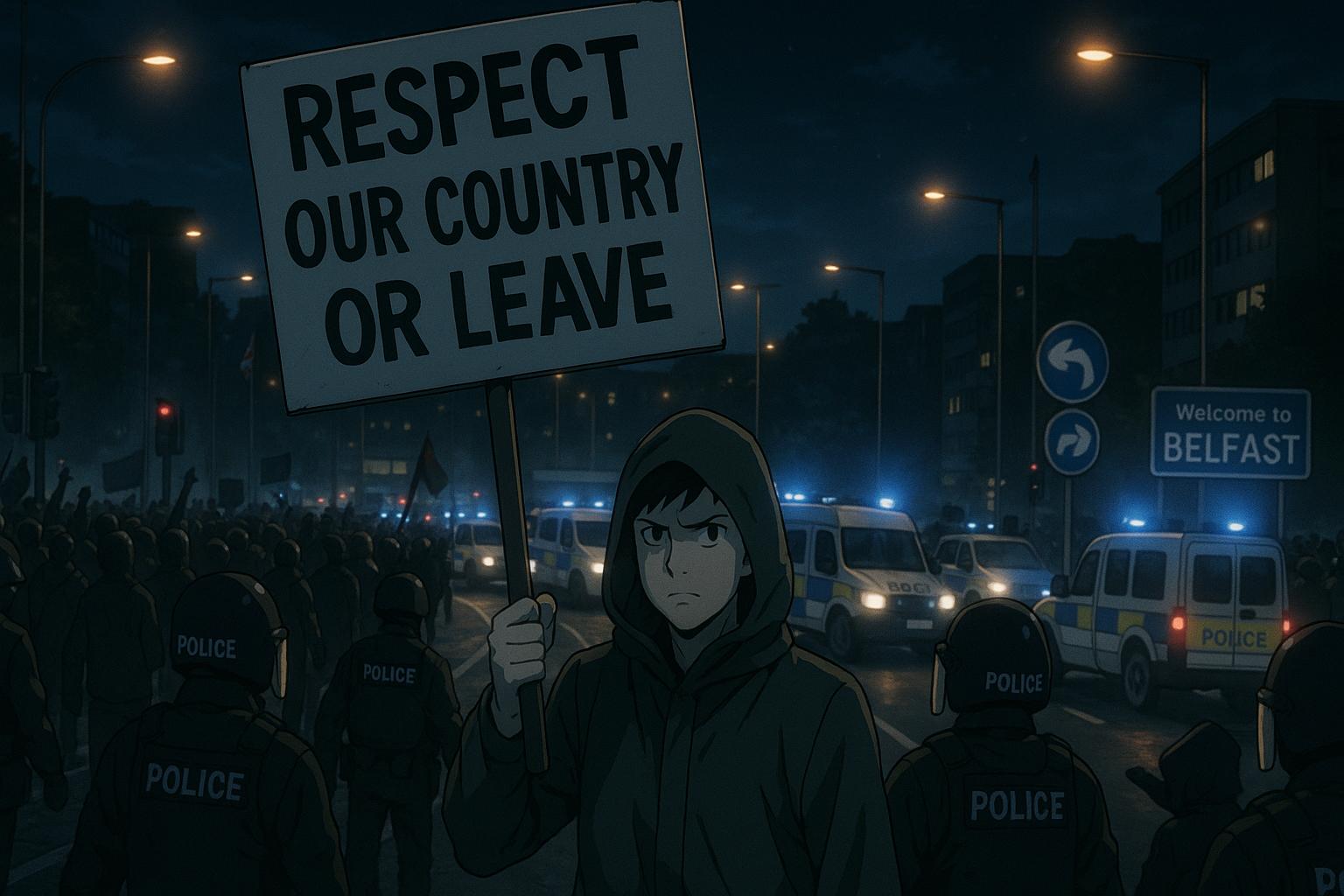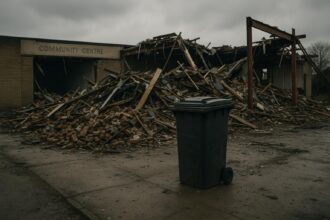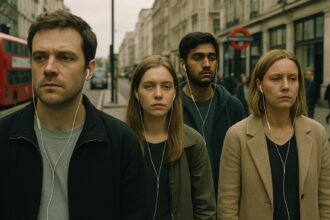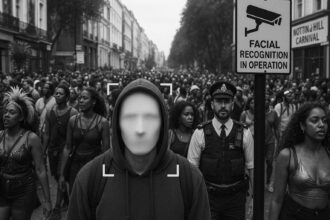Following violent clashes in Ballymena linked to an alleged sexual assault case, small-scale protests erupted in Belfast, disrupting traffic and raising concerns over racially motivated hate crimes amid mounting sectarian tensions in Northern Ireland.
On Tuesday evening, Carlisle Circus in Belfast became the focal point of protests concerning migration, leading to significant traffic disruption. A small group of demonstrators gathered at the busy roundabout, voicing their discontent with a placard that read, “Respect our country or leave.” The protest, which commenced shortly after 6pm, coincided with wider calls for similar demonstrations across Northern Ireland, particularly following violent occurrences in Ballymena the previous day. Although police were present to monitor the situation, as of 7pm, the protest had not escalated significantly, with further protests in Ballymena set to commence later in the evening.
The unrest in Ballymena stemmed from the recent charging of two teenage boys in connection with an alleged sexual assault case. This gathering, initially intended as a peaceful march in support of the alleged victim, devolved into violence, prompting significant clashes with law enforcement. On June 10, violent riots erupted for the second consecutive night, as members of the community engaged in aggressive acts against police, setting vehicles and properties ablaze. Authorities responded with serious force, deploying water cannons and plastic baton rounds against rioters armed with bricks and petrol bombs. This violence resulted in injuries to 15 police officers, some of whom required hospital treatment.
Assistant Chief Constable Ryan Henderson remarked on the situation, condemning the unrest as racially motivated and asserting that attempts to justify the violence were fundamentally flawed. He emphasised the importance of acknowledging the gravity and implications of such actions within the wider societal context. The unrest in Ballymena not only led to widespread property damage, including the burning of a house and multiple vehicles, but it also extended to Belfast where protests caused further road closures.
Political leaders in Northern Ireland have denounced the violence, with many describing the events as “terrible scenes of civil disorder” that have no place in the community. The Police Service of Northern Ireland is actively investigating the incidents as potential hate crimes, underscoring the urgent need for vigilance and accountability in the face of such divisive actions.
In the backdrop of these events, Northern Ireland has a complex history of sectarian and communal tensions. The area has witnessed numerous disturbances over the years, often erupting from unresolved social issues. The current series of protests and disorders reflects not only local grievances but also broader societal fractures concerning integration and community cohesion—a reminder of the difficulties that often simmer beneath the surface in Northern Irish society.
As the situation develops, all eyes will be on both the police response and community actions in the coming days, with hopes that dialogue might emerge from these chaotic events to foster understanding rather than division.
 Reference Map:
Reference Map:
- Paragraph 1 – [1], [4]
- Paragraph 2 – [2], [3]
- Paragraph 3 – [6], [7]
- Paragraph 4 – [5]
- Paragraph 5 – [2], [4]
Source: Noah Wire Services
- https://www.irishnews.com/news/northern-ireland/traffic-disruption-in-north-belfast-as-roundabout-closed-by-protesters-supporting-ballymena-rally-which-turned-into-violence-E6WE7EJTOFF3VDMWJ3COVRBBJU/ – Please view link – unable to able to access data
- https://www.reuters.com/world/northern-irish-rioters-attack-police-second-night-2025-06-10/ – On June 10, 2025, Ballymena, Northern Ireland, experienced intense rioting for the second consecutive night following a protest over an alleged sexual assault case involving two teenage boys. Hundreds of masked rioters attacked police and set cars and homes ablaze, leading to severe disorder throughout the town. Police responded with armored vehicles, water cannons, and plastic baton rounds as they faced a barrage of petrol bombs, scaffolding, and rocks. One house was completely burned, and a police officer became ill after escaping another home targeted by arsonists. On the first night of disturbances, four homes were damaged by fire, and additional homes and businesses suffered broken windows and doors in what authorities are investigating as racially motivated hate crimes. Fifteen police officers were injured on Monday, with some requiring hospitalization. The unrest extended slightly to Belfast, where some roads were blocked during protests, though no major incidents were reported there. British and Northern Irish political leaders, including Northern Ireland Minister Hilary Been, condemned the violence, declaring such “terrible scenes of civil disorder” have no place in the region. ([reuters.com](https://www.reuters.com/world/northern-irish-rioters-attack-police-second-night-2025-06-10/?utm_source=openai))
- https://apnews.com/article/9952fa07928ce2337453a6609a3f2d5a – In Ballymena, Northern Ireland, a second consecutive night of anti-immigrant violence saw demonstrators attack police with bricks, bottles, and fireworks, and set vehicles and houses on fire. Police employed water cannons and plastic baton rounds to disperse the crowd of several hundred. The unrest followed a peaceful march in support of a sexual assault victim, after which two 14-year-old boys were charged in connection with the alleged assault. The accused, supported in court by a Romanian interpreter, have not been named due to their age. The Police Service of Northern Ireland reported that 15 officers were injured during the incidents. Assistant Chief Constable Ryan Henderson condemned the violence as racially motivated and vowed to bring the perpetrators to justice, stating that attempts to justify the actions are “misplaced” and should be universally criticized. ([apnews.com](https://apnews.com/article/9952fa07928ce2337453a6609a3f2d5a?utm_source=openai))
- https://en.wikipedia.org/wiki/2025_Ballymena_riots – The 2025 Ballymena riots began on June 9, 2025, in Ballymena, County Antrim, Northern Ireland. The unrest was initially triggered by the charging of two Romanian teenagers for the sexual assault of a girl. On the first night of disorder, two police cars and multiple properties were damaged, with 15 police officers being injured. Rioting continued for a second night, with violence spreading to other areas, including Belfast, where protests led to road blockages and traffic disruptions. The Police Service of Northern Ireland investigated the incidents as racially motivated hate crimes. ([en.wikipedia.org](https://en.wikipedia.org/wiki/2025_Ballymena_riots?utm_source=openai))
- https://www.irishtimes.com/news/crowd-of-100-goes-on-rampage-in-ballymena-1.1181781 – In August 2005, a crowd of about 100 youths caused a disturbance in Ballymena, County Antrim, Northern Ireland. The group gathered in the Warden Street area in the early hours after leaving a social club, smashing windows and damaging cars. A police spokeswoman reported that several houses had their windows smashed and some cars were also damaged. Detectives appealed for anyone with information to come forward. ([irishtimes.com](https://www.irishtimes.com/news/crowd-of-100-goes-on-rampage-in-ballymena-1.1181781?utm_source=openai))
- https://www.belfasttelegraph.co.uk/news/northern-ireland/teen-arrested-as-47-police-officers-hurt-in-belfast-sectarian-riots/28788269.html – In August 2012, disturbances occurred in the Carlisle Circus area of north Belfast following a parade. Loyalist and Republican groups clashed, leading to injuries among police officers. A teenager was arrested in connection with the riots. The disturbances were part of a series of sectarian tensions in the region during that period. ([belfasttelegraph.co.uk](https://www.belfasttelegraph.co.uk/news/northern-ireland/teen-arrested-as-47-police-officers-hurt-in-belfast-sectarian-riots/28788269.html?utm_source=openai))
- https://www.irishexaminer.com/news/arid-30218090.html – In August 2005, a gang of around 100 youths caused a disturbance in Ballymena, County Antrim, Northern Ireland. The group gathered in the Warden Street area in the early hours after leaving a social club, smashing windows and damaging cars. A police spokeswoman reported that several houses had their windows smashed and some cars were also damaged. Detectives appealed for anyone with information to come forward. ([irishexaminer.com](https://www.irishexaminer.com/news/arid-30218090.html?utm_source=openai))













